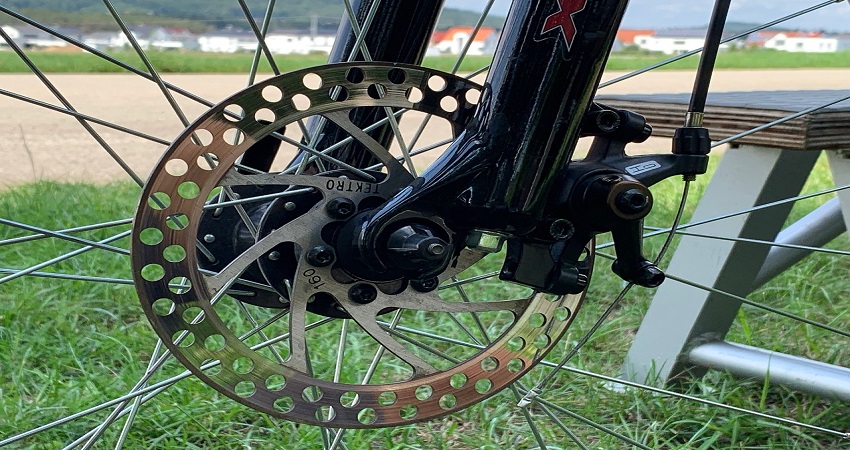Yes, mountain bike handlebars can be raised to optimize comfort and posture while riding. By adjusting the stem height or using a riser handlebar, riders can achieve a higher position for better control and reduced strain on the back and shoulders.
Mountain biking is an exhilarating adventure that pushes the limits of riders and their bikes. To enhance the riding experience, many bikers often wonder if they can adjust their handlebars for improved comfort and performance. The answer is a resounding yes! We will explore how mountain bike handlebars can be raised to optimize posture and ensure a comfortable ride.
Whether you are a seasoned rider or new to the sport, understanding how to properly adjust your handlebars can greatly impact your biking experience. So, let’s dive in and discover the various methods by which you can raise your mountain bike handlebars.
Benefits Of Raising Mountain Bike Handlebars
Raising mountain bike handlebars can provide several benefits. By increasing the height, riders can achieve a more comfortable and ergonomic riding position, reduce strain on the back and neck, and enhance overall control and maneuverability. This simple adjustment can significantly improve the biking experience on rugged terrains.
Improved Comfort
Raising your mountain bike handlebars can have several benefits when it comes to improving your comfort while riding. With the handlebars at a higher position, you can achieve a more upright riding position, reducing strain on your back and neck. This is particularly beneficial for riders who may have pre-existing back or neck issues. By alleviating the pressure on these areas, you can ride for longer periods comfortably, allowing you to explore new trails and enjoy your mountain biking adventures to the fullest.
Enhanced Control
Having your mountain bike handlebars raised also enhances your control over the bike. When the handlebars are positioned higher, you can exert more leverage, making it easier to navigate through tricky terrains. The elevated position of the handlebars gives you better balance and stability, allowing you to maneuver the bike more effectively. With improved control, you can confidently tackle technical trails and obstacles, enhancing your overall riding experience.
Having discussed the benefits of raising mountain bike handlebars, it is clear that this adjustment can greatly enhance your riding comfort and control. By achieving a more upright position, you can reduce strain on your back and neck, enabling you to ride for longer without discomfort.
Additionally, the elevated handlebar position grants you better control over your bike, making it easier to maneuver through challenging trails. So, if you’re looking to improve your mountain biking experience, consider raising your handlebars and enjoy the benefits it brings.
Factors To Consider Before Raising Mountain Bike Handlebars
Before raising mountain bike handlebars, it’s important to consider factors such as your riding style, comfort, and bike geometry. Assessing these aspects will help determine if adjusting the handlebar height is suitable for you.
Bike Fit
One of the crucial factors to consider before raising mountain bike handlebars is bike fit. Proper bike fit ensures comfort, stability, and optimal performance for riders of all levels. When it comes to handlebars, the height and angle play a significant role in achieving a comfortable riding position.
Before making any adjustments to the handlebars, it’s important to assess your current bike fit. This involves considering your riding style, body proportions, and any potential discomfort or injuries. An ill-fitting bike can lead to pain, numbness, or even injuries, so it’s crucial to make adjustments that accommodate your specific needs.
If you’re experiencing discomfort in your neck, back, or wrists, it may be an indication that your handlebars need adjusting. Raising the handlebars can alleviate strain on these areas and offer a more upright riding position. However, it’s essential to understand the potential impact of raising handlebars on your overall riding experience.
Riding Style
Another factor to consider before raising mountain bike handlebars is your riding style. The handlebar height directly affects your riding posture and can significantly impact your control and maneuverability on the trails.
For riders who prefer a more aggressive riding style, lower handlebars may be desirable as they offer a more aerodynamic position for faster speeds and better handling when navigating technical terrains. On the other hand, riders who prioritize comfort and endurance may benefit from raising their handlebars to reduce strain on the upper body and maintain a more relaxed riding posture.
It’s important to strike a balance between comfort and performance based on your personal preferences and riding goals. Experimenting with different handlebar heights can help you find the optimal position that allows you to ride efficiently and enjoyably.
Methods For Raising Mountain Bike Handlebars
When it comes to finding the perfect riding position on your mountain bike, handlebar height plays a crucial role. A comfortable handlebar height allows you to maintain control, prevent strain on your back and neck, and enjoy a more enjoyable ride. Luckily, adjusting the height of your mountain bike handlebars is a relatively simple task that can be done in a few different ways. In this article, we will explore three popular methods for raising mountain bike handlebars: adjusting the stem, using riser handlebars, and adding stem spacers.
Adjusting The Stem
One of the most common methods for raising mountain bike handlebars is by adjusting the stem. The stem is the component that connects the handlebars to the fork’s steerer tube.
To adjust the stem, follow these steps:
- Loosen the stem bolt or bolts located on top of the stem.
- Raise the stem by gently pulling it upwards.
- If necessary, align the stem with the front wheel for optimal control.
- Once satisfied with the height and alignment, tighten the stem bolt or bolts.
Using Riser Handlebars
Another effective method for raising mountain bike handlebars is by using riser handlebars. Riser handlebars are designed with a higher profile, allowing for a more upright riding position.
To install riser handlebars, follow these steps:
- Remove the grips and shifters from your current handlebars.
- Unscrew the stem bolts and remove the handlebars from the stem.
- Slide the riser handlebars onto the stem.
- Secure the riser handlebars using the stem bolts.
- Reinstall the grips and shifters onto the riser handlebars.
Adding Stem Spacers
Adding stem spacers is a simple and cost-effective way to raise your mountain bike handlebars. Stem spacers are rings that fit between the stem and the top of the fork’s steerer tube, effectively increasing the height of the handlebars.
To add stem spacers, follow these steps:
- Loosen the stem bolt or bolts located on the top of the stem.
- Slide the stem upwards to expose the steerer tube.
- Place the desired number of stem spacers onto the steerer tube.
- Reposition the stem onto the spacers and align it with the front wheel.
- Tighten the stem bolt or bolts to secure the stem and spacers in place.
By using these methods, you can easily raise the handlebars of your mountain bike and achieve a more comfortable riding position. Consider trying one or a combination of these methods to find the perfect handlebar height for your biking adventures.
Tips For Properly Raising Mountain Bike Handlebars
Raising the handlebars on your mountain bike can greatly improve your riding experience, relieving stress on your back, shoulders, and neck. Properly adjusting the handlebars can also enhance control and maneuverability, especially when tackling tough trails. In this section, we will provide you with some essential tips for raising mountain bike handlebars to ensure a comfortable and efficient ride.
Start Slowly
When it comes to adjusting your mountain bike handlebars, it’s important to start slowly and make gradual changes. Sudden and drastic adjustments can negatively impact your bike’s stability and handling. Begin by loosening the stem bolt with a suitable Allen key. Be cautious not to loosen it too much, as the stem may come loose.
Once the bolt is loosened, you can carefully raise the handlebars to your desired height. Make small adjustments, raising them incrementally to find the perfect position. Remember, it’s better to make several small adjustments rather than one large one.
Consider Professional Help
If you’re unsure about how to properly raise your mountain bike handlebars or lack the necessary tools, it’s always a good idea to seek professional help. Local bike shops or experienced bike mechanics can provide expert guidance and assistance in adjusting your handlebars to the optimal height.
Professional assistance ensures that the handlebars are set up correctly, taking into account factors such as your riding style, body measurements, and personal preferences. They will also ensure that all components are tightened properly to avoid any potential issues on the trail.
Check For Proper Alignment
After adjusting the height of your mountain bike handlebars, it’s vital to check for proper alignment. Ensure that the handlebars are square with the front wheel, allowing for even weight distribution and a balanced riding position.
To check the alignment, stand in front of your bike and look down the length of the stem towards the front wheel. The handlebars should be parallel to the front wheel and not angled to one side. If you notice any misalignment, gently adjust the handlebars until they are parallel to the wheel.
Remember to tighten the stem bolt securely once you have achieved the desired handlebar position and alignment. This will ensure that your handlebars stay in place during your rides.
By following these tips, you can safely and effectively raise the handlebars on your mountain bike. Whether you choose to make the adjustments yourself or seek professional assistance, properly adjusting the handlebars will enhance your comfort, control, and overall enjoyment of your biking adventures.
Frequently Asked Questions For Can Mountain Bike Handlebars Be Raised?
Can Mountain Bike Handlebars Be Raised?
Yes, mountain bike handlebars can be raised by adjusting the stem. Loosen the stem bolts and adjust the handlebar height to your preferred position. Make sure to tighten the bolts securely to ensure safety during rides. Raising the handlebars can provide a more comfortable and upright riding position, especially for riders with back or neck pain.
What Are The Benefits Of Raising Mountain Bike Handlebars?
Raising mountain bike handlebars offers several benefits. It can improve comfort by reducing strain on the back, neck, and arms. It also provides better control and stability, especially on rough terrains. Additionally, raised handlebars enable riders to have a more upright position, which increases visibility and reduces the risk of accidents.
Are There Any Limitations To Raising Mountain Bike Handlebars?
While raising mountain bike handlebars can enhance comfort and control, there are some limitations to consider. Raising the handlebars too high may affect the bike’s handling and maneuverability. Excessive height adjustments can also put additional stress on the headset and stem, potentially causing damage.
It’s important to find a balance between comfort and maintaining the bike’s overall stability.
How High Can Mountain Bike Handlebars Be Raised?
The height to which mountain bike handlebars can be raised depends on several factors, including the bike’s design and the length of the steerer tube. Generally, handlebars can be raised by a few inches. However, it’s essential to ensure that the stem’s minimum insertion mark is still visible and that the handlebars are securely tightened to avoid any accidents or damage.
Conclusion
To summarize, raising mountain bike handlebars is not only possible but also a valuable adjustment for riders seeking improved comfort and control. By following the proper techniques and using the appropriate tools, cyclists can achieve a more upright riding position and alleviate stress on the wrists, shoulders, and back.
This modification can greatly enhance the overall riding experience, allowing for longer rides and increased enjoyment on the trails. So, go ahead and explore the option of raising your handlebars to discover a whole new level of biking comfort!



